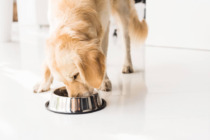Humanization: From Dog Owners to Dog Parents

DogFoodAdvisor is reader supported See how
Dog Food Advisor is 100% impartial and is never paid to promote any brand. But if you buy using links on this page, we may earn a referral fee.
Your dog is part of your family. And when we say that, we mean it. You talk to them like a family member, you include them in family gatherings, they appear in family portraits, they might accompany you on vacation. They’re always there for you.
What would we do without them?
We’re all pet parents here at Dog Food Advisor, not owners. A lot of people will refer to their “furry child”. This is a significant change and one that’s accelerated in recent years, particularly among younger generations.
Despite humans having first domesticated dogs around 15,000 years ago, until very recently dogs have usually performed a job or served a purpose within the home — often to help hunt, farm or protect.
Around 2,000 years ago, in Roman times, they began to live inside the home. They were still seen as pets, though, perhaps becoming companions over time, but not members of the family until very recently.
These days, dogs are increasingly becoming more than just a “best friend”, and in many cases an actual substitute child — a phenomenon seen more and more among younger pet parents, in particular with Millennials (born between 1981 and 1996) and Generation Z (born between 1997 and 2011).
What is pet humanization?
Market research firm Packaged Facts conducted a 2024 survey which found 76% of U.S. pet parents strongly agree their pet is part of the family — up from 69% just eight years earlier in 2016 1. But pet humanization goes a step further than simply thinking of your dog as an extended, furry family member.
As with everything, there are different levels to this.
‘Humanization’ is where people effectively see their dog as a human and will treat them like their own offspring. They’ll provide them with the best food possible, purchase products to boost their health, buy them expensive toys, beds and clothing with a focus on quality at whatever price and often — often sacrificing purchases for themselves to fund this. They see their dog as someone who’ll always be there for them and be part of their family unit.

Psychotherapist, clinical hypnotherapist and wellness coach Geraldine Joaquim says parents humanizing their dogs often links into the psychological concept of the extended self.
“Parents develop a metaphoric relationship with the pet that goes beyond simple owner/possession boundaries, attributing characteristics and determining the likes and dislikes of the pet as if they were a mini version of themselves when, in reality, it’s merely a reflection of their own self-identity,” she says.
“For example, by dressing their dog up in a particular style of clothing that matches the owner’s own choices, the dog therefore becomes a visual extension of themselves.”
What’s the difference between humanization and anthropomorphism?
Anthropomorphism is assigning human characteristics to your dog, for example, saying “When Rex chews on that stick and holds it between his paws he looks like your uncle eating an ice cream”.
Humanization, meanwhile, is seeing your dog as an actual human being and treating them as such. Those videos you see of dogs in fancy dress eating posh, hand-crafted meals on social media? That’s humanization, and that trend is fuelling the increase in demand for high-quality food and luxury items for your dog.
“Humanization is more about reflecting the owner’s health, well-being and morality — essentially, the pet becomes an extension of the owner,” says Joaquim.
“The pet parent makes decisions based on their personal values rather than the animal’s actual requirements, which can sometimes prioritize the owner’s needs over their dog’s, for example excluding meat from your dog’s diet.”
Why is pet humanization increasing?
“When you delve into it, pet ownership is all about love for most people,” says Joaquim. “In an increasingly disconnected society where younger generations often have more online contacts than real-life ones, having a pet, i.e. something real to pour love into, makes perfect sense.
“For younger pet parents it’s a time of burgeoning independence after years of being boxed into conforming through the educational years when there’s little control or choice. For many, having a dog can represent that step into adulthood — the responsibility of ownership but also being in control to make that choice and, further, as a representation of self-identity through humanizing it.”
Joaquim adds there’s also an element of fitting in with others, whether that’s virtually (through following online trends) or in reality (aligned beliefs and trends of real-life friends). “Being able to assert your identity in a safe environment — one where you’re accepted and not ridiculed — which engenders a sense of belonging is something we all crave to some degree.
“Through humanizing your dog, there’s a feeling of creating a higher level of communication, which serves to fulfill a need within the parent for acceptance, self-expression, status, self-value, emotional support, companionship and positive associations with the extension of self.
“We’re more aware of what we do, say, wear, and the image we project, than at any other time in our lives. There’s an intrinsic need to fit in with our social groups while at the same time creating an individual footprint, and your choice of pet and how you present it forms a part of that.”
What are the effects of pet humanization?
One of the main effects of humanizing your dog is how it impacts your purchasing choices — something businesses in the pet industry are well aware of and cater for/take advantage of.
Often it leads to pet parents purchasing products they’d consider using themselves. So, in terms of food choices, it might mean buying organic or vegetarian dog food if you eat that specific diet yourself. It’ll certainly mean looking for things like fresh ingredients, human-grade dog food, or traceable or sustainable ingredients.
 Organic Dog Foods”>
Organic Dog Foods”>
These dog parents are often less concerned with cost and, in many cases, are prepared to go without themselves in order to ensure their dog has the highest quality food.
It may also mean buying birthday cakes for your dog, taking them on holiday with you to dog-friendly hotels, keeping up-to-date on dog health trends, spending more at the vet or on pet insurance or, at the more extreme end, dressing your dog like a human and pushing them in a stroller.
It may also mean spending more on fashionable items for your dog that are in line with your own fashion choices, and a willingness to splash the dollars for them. This results in brands producing goods to provide this market with more choice.
Data from NIQ 2 found the average spend per pet parent has increased, and the average value in 2022 was $680, up 11%. Gen Z spend most per generation, with an annual spend of $1,885 on their dog’s health and well-being, $723 above average 3.
One problem that can occur as a result of humanization is behavioral issues, warns Joaquim. “The boundaries for the pet can become blurred and life becomes confusing. Dogs are much happier when there are clear routines and parameters. When they know what to expect and what’s expected of them they feel more secure and therefore content, which results in better behavior.”
Excusing poor behavior by humanizing it (e.g. “They’re just having a tantrum” or “They’re showing their love for me by attacking you”) is not a good solution.
One other impact of humanization is when your beloved dog dies. Many people now find it impossible to get a new dog because they can’t imagine “replacing” what they see as their child — the emotional bond is too strong.
“Having a pet naturally opens you up to grief, but when we see them as human equals that can make what is a painful time even harder,” says Joaquim. “That’s not to suggest you can simply replace a dog by buying a new one — each dog has its own unique character — but having perspective is important.”
Cascadia Capital’s 2024 overview, as reported in Pet Industry News, found that younger generations’ views on pet ownership fits in with this, differing from previous generations: “Their motivations as a cohort are centered around enabling their pets to live longer, happier and more mobile lives, often serving as a constant companion in lieu of family formation,” said the report.
How does pet humanization affect dog food choices?
Research, led by CoBank’s Knowledge Exchange and titled Seeking Wellness, Younger Pet ‘Parents’ Spur Pet Food Growth Trends, found these younger pet parents are leading new trends by being willing to purchase increasing numbers of products built around health and wellness.
These generations have grown up during a time when perceptions of what’s healthy have transformed the way they eat and exercise.
Many seek food created using fresh, highly nutritional ingredients in their own diets, so it follows that they wish to provide their pets a diet made from similar ingredients.
 Fresh Dog Food”>
Fresh Dog Food”>
Indeed, a 2019 study 4 examining pet food purchasing influences uncovered a surprising trend: 44% of respondents said buying healthy food was more important for their pet than for themselves. The study labeled this the ‘Health Prioritization Gap’.
Statistics show Millennial and Gen Z pet parents are buying more fresh food to feed their pets, going hand-in-hand with the increased humanization of dogs.
It’s had an impact; statistics show fresh dog food sales have increased 86% since 2021.
Social media again plays an important part in dog food choices, with younger generations getting much of their information about food and canine products from TikTok and Instagram. This is where savvy brands have increased their presence and tapped into these audiences, designing advertising directly consumed by Millennials and Gen Z with an emphasis on how they see their dogs.
Final word
The Dog Food Advisor does not accept money, gifts, samples or other incentives in exchange for special consideration in preparing our reviews.
However, we do receive a referral fee from online retailers (like Chewy or Amazon) and from sellers of perishable pet food when readers click over to their websites from ours. This helps cover the cost of operation of our free blog. Thanks for your support.
For more information, please visit our Disclaimer and Disclosure page.



